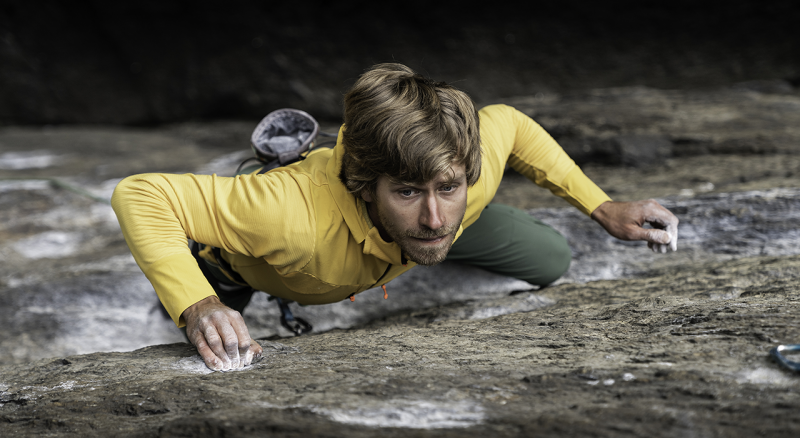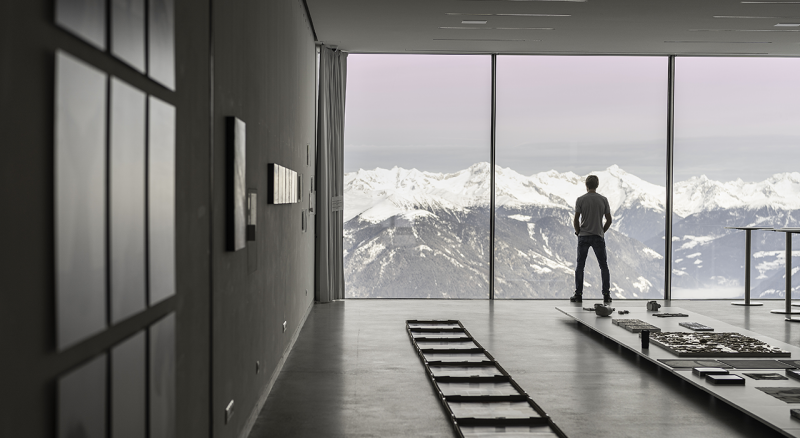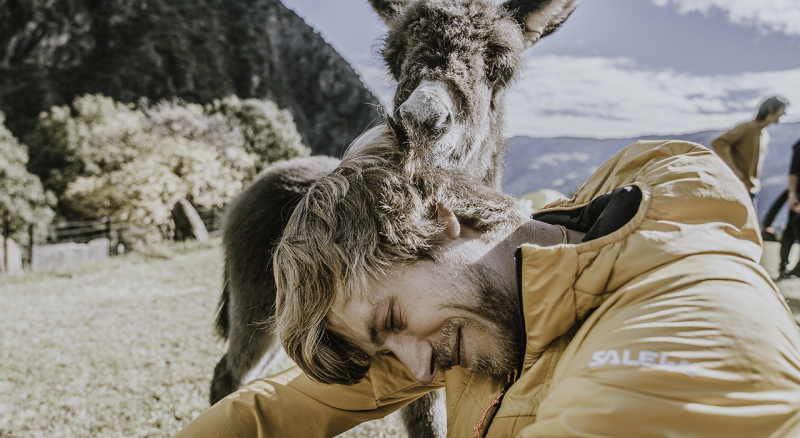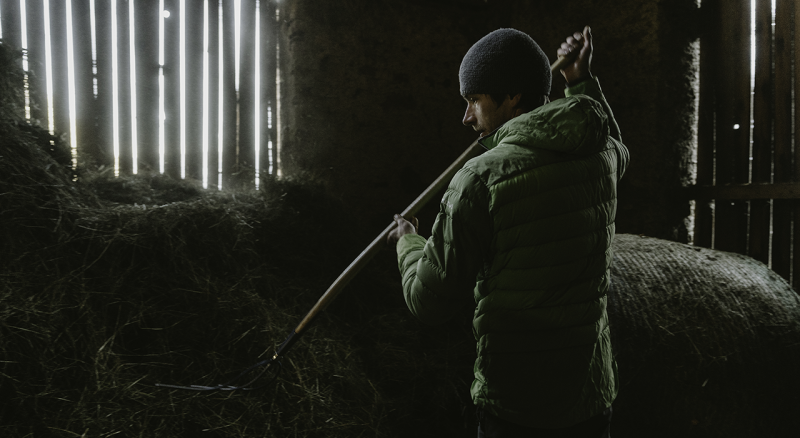AMIDST LEGACY, SOLITUDE AND NATURE
SIMON MESSNER’S ALPINE LIFE
His real name doesn't appear on the doorbell.
Right there, outside the wrought-iron gate, you can still see the temporary label that the electricians put on the intercom's backlit touchpad. It's there, in capitals: one of those names that vaguely brings to mind the American action filmstars with their box-office hits. I wish I could tell you who it is, I really do. But he wouldn’t be very happy.
“Trust me, you can’t write the name Messner on the doorbell.” He says it almost under his breath, more out of the embarrassment that this causes him than the fear that someone may really overhear him.
INNOVATIVE?
Like his father, Simon is a mountaineer.
As well as his father’s features, Simon has inherited his traditional, explorative climbing style, inspired by the philosophy of not invading the mountains but merely climbing them. Some say that Simon's approach is innovative, yet he is the first to point out that his style of mountaineering is nothing new. It is, in fact, rooted in the very concept of mountaineering itself. It’s the style of Paul Preuss, Emilio Comici, Riccardo Cassin, Hermann Buhl and Walter Bonatti. Simon's method takes its inspiration from none other than a young Reinhold's manifesto, ”The Murder of the Impossible”, published in 1968 in the CAI (Italian Alpine Club) magazine.
PAPILLON 1973
Growing up between Alto Adige, Munich and Kathmandu, Simon spent his childhood in a typically cosmopolitan world, developing the curiosity, sensitivity and mental elasticity of one not in pursuit of a superficial life. The young Simon sought answers to a million and one questions, shaping his character and his spirit towards continuously exploring the unknown. Simon got his education from the history of mountaineering and it did make him dream. Yet in the beginning, it didn't have him dreaming of mountaineering, as a kind of non-practising belief.
In fact, Simon hasn’t always been a mountaineer. He initially rejected the mountains which, these days, he loves with a passion. Being born and growing up in a home where, in his words “every story and every thing began and ended with the mountains”, sheer saturation pushed him to paths far-removed from mountaineering. Simon had an automatic disassociation whereby, as his grandmother would say “the dough is the crumb's companion”, or, as we would say, there was “too much of a good thing.” Simon is like the character from Papillion. The mountains are the prison from which he must escape.
RELATED PRODUCTS
SET IT ASIDE
Yet Simon was a child of Art with a capital “A”. He is the son of a human being who is closer to the realm of the divine, a person who changed the very concept of his Art form. Just like Jesse Owens, Dick Fosbury, Michael Jordan, Muhammad Alì, and the other gods whom you may well choose, depending on your personal preferences. The concept is rather simple: as much as he may have wanted to propel himself in the opposite direction to his roots, it wouldn’t have mattered, because in the eyes of the world, Simon would always have been just “the son of the King of the eight-thousanders”, the son of a living legend.
THREE
Surrounded by mountains wherever his gaze, ears or mind turned, it was inevitable that, sooner or later, an encounter was bound to happen. And that encounter happened through climbing. He bought three quickdraws (three quickdraws in total to be exact) from a store and set off to discover what these mountains were all about, the ones which his father spoke about so much, the mountains for which he had nurtured such disdain. Simon had to understand.
“Simon couldn’t manage to climb two metres off the ground before he was hit by a strong feeling of vertigo, which paralysed him. He slowly got to know vertical climbing.” Hanspeter Eisendle
That was the day when, aware of his limits, Simon challenged the feeling of the void: he confronted fear for the first time. He climbed. He was scared, but he climbed. Simon wasn’t able to fully understand it up there. But that day, the call of fear, “that unwanted, unexpected guest, yet at one with man”, accompanied him to a lucid epiphany: tales of overseas expeditions, makeshift bivouacs, unclimbed peaks, impossible climbs and, yes, the void took on a sense of revelation. Simon’s rejection turned into complete meaning. From that day, Simon took the most difficult fork in the road of all: to do mountaineering, to become a mountaineer. Fear and adventure coexist with harmony and respect in the life that Simon has chosen for himself. The same one whereby he plays the exciting game of keeping free of conventions, legacy and the past. The past represents pages that are to be studied to understand the future better, in order to write new pages. Or to buy a full set of quickdraws perhaps.
MEMENTO
Simon has been living with his partner Anna for several years. They met in Innsbruck, when they were both university students in the Biology department. Anna had only heard distant whisperings of the legend of Reinhold Messner. She herself says that she only knew that he was a “old man with a beard”. She and Simon liked each other right away and they’ve been together for years. They recently moved to Juval, in Alto-Adige, where Simon inherited a farmstead to be restored and, with it, all the responsibilities that this brings. It is a task that undoubtedly doesn't go well with the idea of mountaineering. For Simon, roots, traditions and history come before even mountaineering. It’s a plot based on reality, time and memory, like one of Christopher Nolan's best films.
Simon’s days are filled with sunshine. Indeed, they follow the sun, just like in the Himalayas. The donkeys are fed first, then the horses, and, last but not least, the goats and pigs. The barn needs rebuilding, while leaks must be patched up in the farmhouse roof. The lawn has to be kept clean, the restaurant has to be run and the books need to be balanced. And it’s already evening, which is spent dreaming of the mountains and Nature.
NATURE, TO BE EXACT
The rest doesn’t matter. Simon knows that. Perhaps that’s why he wants an alpine life, as close as possible to the rhythm of light, water, earth and air. Although it’s difficult, it’s an adventure for sure. My teacher said that “there can be no adventure without difficulty, without the unknown”.
That boy with an unfortunate name, who unreservedly shut out the world of mountain peaks, has come back. And he will come back with the same curiosity which, whether he likes or not, his father wanted to pass on to him.
And he will still be the son of someone. But different. Free.
ALL THE SOUND OF LONELINESS
Is this the sound it makes? Is this the force of our breath echoing in our steps? To look at, it’s a speck in the middle of nothing. Yet for Simon, it’s a little bit of everything. There’s no one else around him. Only Simon’s shadow stands behind him.
Solitude is a necessity that becomes an act of responsibility in the mountains. Simon likes to climb alone, untethered. He doesn't do it become he has to. Simon does it because he feels like it. “Mountaineering is selfishness” he says. And “there you have it, selfishness, the eternal criticism of the lover of solitude” I say. But Simon’s not selfish. Such naive, simple primordiality spirals to a baseline condition that goes towards a real whole, a whole to be grasped by most. Simon is how he is, and that’s fine. And Nature embraces him because of it. Everything starts and ends there. Nature has no beginning and no end. Nature is around him and inside of him.Nature is his home. Nature gives and nature takes away. Simon has no avatar, he only resembles himself.

 Free shipping on orders over $200 - No minimum for registered users
Free shipping on orders over $200 - No minimum for registered users










